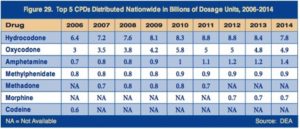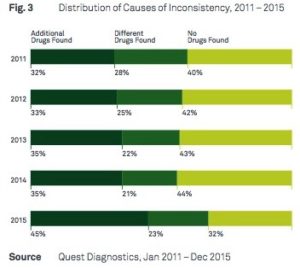
Heroin sales and overdoses get a significant mount of attention, but we need to also remember that since 2002, the number of deaths related to controlled prescription drugs (CPD) have outpaced those for cocaine and heroin COMBINED. And the number of individuals who report current use of CPDs is more than those reporting use of cocaine, heroin, methamphetamine, MDMD and PCP (phencyclidine) combined. Each day, 129 individuals die from a drug overdose in the U.S. And yes, five of the seven most prescribed CPDs are opioids. The other two are amphetamine (i.e., Adderall) and methylphenidate (i.e., Ritalin and Concerta).
This information was taken from a yearly statistical summary published by the DEA called the National Drug Threat Assessment (NDTA). The 2016 NDTA Summary covers a wide range of data and classes of drugs. There’s even information on the various drug cartels operating in the U.S. This article will focus on CPDs.
The first figure (Figure 26) gives a comparison of the drug poisoning deaths for prescription drugs, cocaine and heroin from 2007 to 2014. Then Figure 29 shows the top five CPDs distributed nationwide in the BILLIONS of dosage units. Far and away from all the other CPDs, hydrocodone and oxycodone are the most prescribed drugs in the U.S. Both of these figures were taken from the 2016 NDTA Summary.
Not surprisingly, the number of admissions to publically funded treatment facilities for non-heroin opiate/synthetic abuse was 24% higher in 2013 than in 2008. The number of admissions has declined since 2011, but that has been offset by an increase in heroin use between 2011 and 2013.
Recently there has been an increase in the abuse of stimulant medications, specifically amphetamine. Between 2006 and 2011 the nonmedical use of Adderall increased by 67%. Emergency department visits related to Adderall almost tripled between 2005 and 2010. Misuse of ADHD medications as a class resulted in a 76% increase in poison control interventions from 2005 to 2010.
Young adults 18-25 years old represent the majority of the increase in Emergency Department visits, despite children comprising the largest subset of ADHD diagnoses. Many high school and college age students display limited knowledge of either the side effects or the addictive nature of Adderall. This coincides with the popular reputation of the drug on college campuses as a study-aid to improve concentration, and not something harmful or addictive. This contributes to the increased rate of non-medical use among adults.
Looking at concerns with prescription drug use and misuse from another perspective, a report by Quest Diagnostics suggested many Americans are misusing their prescription drugs. In their 2016 Prescription Drug Monitoring Report, Quest Diagnostics found that 54% of patient specimens showed signs of prescription drug misuse. For the purposes of their analysis, a consistent result was when a patient was taking a prescribed drug appropriately. An inconsistent result meant the patient was either not taking their prescribed drug, was taking drugs in addition to those that were prescribed, or was taking drugs that hadn’t been prescribed to them. These three combined causes of “inconsistent test results” indicated potential drug misuse in the Quest report.
About 45% of the inconsistent specimens showed evidence of patients taking drugs in addition to what was prescribed to them, “suggesting the potential for dangerous drug combinations in a sizeable number of patients.” This 2015 finding was considerably higher than other years. STAT News quoted Quest’s medical affairs director as saying, ““The discovery that a growing percentage of people are combining drugs without their physician’s knowledge is deeply troubling, given the dangers.” Of particular concern is the combination of opioids and sedatives, which can lead to respiratory depression, coma and death. The following graphic was taken from the Quest Diagnostics report.
Quest also examined the drug groups associated with the highest number of inconsistencies, by age groups. Unfortunately, given their composite sense of “inconsistent test results,” it is not clear what caused the top inconsistent drug classes. For example, we can speculate that in the under age 10 category, the top two drug inconsistent classes (amphetamine and methylphenidate) were likely due to no drug found, meaning those children were prescribed, but not taking their ADHD medications. The same can be said for the various places that “marijuana metabolite” appeared. However, the inconsistent classes for benzodiazepines, opiates and oxycodone are not distinguished by cause. So while benzodiazepines are noted as the top inconsistent drug class for every age group over 25, it is not clear if that meant they were taken in addition to what was prescribed or not.
One exception to this was with heroin and benzodiazepines. Quest found 1.56% of their tests were positive for heroin. Among adults who tested positive for heroin, 28.6% were also positive for benzodiazepines. Among those who combined these two drugs, 92.3% of the benzodiazepines were not prescribed.
The Fix, an addiction and recovery website, enlisted Peter Grinspoon, the author of Free Refills: A Doctor Confronts His Addiction, to look at the study. Dr. Grinspoon observed that Quest Diagnostics is in the business of doing urine drug testing, so they are interested in promoting drug testing. He went on to say:
Drug tests simply aren’t that accurate. They’re subject to human and lab error, and are rife with both false positives and false negatives. Savvy drug users can outsmart these tests. Any drug testing needs to be interpreted in the context of who is using the drug and why they are using it.
It is true that Quest Diagnostics makes money by increasing the amount of urine testing it does; that it is interested in promoting and highlighting drug-testing. But this was the fifth Prescription Drug Monitoring Report done by Quest. Additionally, Quest provides testing services to about half of all physicians and hospitals in the U.S. So the claim in the report, that it is “well positioned to identify trends in prescription drug monitoring and misuse” is legitimate.
Further, Dr. Grinspoon’s comments on the inaccuracy of urine testing seem overstated. Yes, there are false positives and negatives; and labs can make mistakes. But he gave the impression these errors happen so often that drug testing was a questionable, unreliable procedure. The FDA, among other sources, considers laboratory testing of urine samples to be the most reliable way to confirm drugs of abuse.
He also seems to assume the testing in the Quest report included drug users given urines as part of their treatment within drug treatment programs, which is not the case. Quest specifically stated that drug rehabilitation clinics and addiction specialists were excluded from the analysis “given the higher rates of testing and potentially higher rates of inconsistency.” There is no reason for a drug user to want to outsmart a urine test done in conjunction with their ongoing medical treatment that I can imagine.
The bottom line is that I think the Quest Prescription Drug Monitoring Report still provides helpful and valuable information on the dangerous practice of combining prescription medications. But prescription drug misuse is just one third of a kind if opioid shell game. Along with heroin and fentanyl, it keeps us trying to guess where the next opioid crisis will be.








